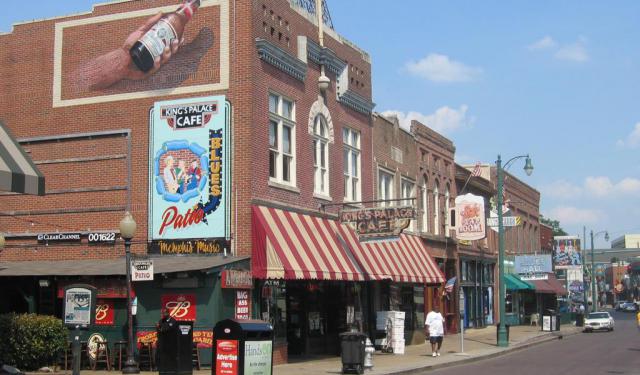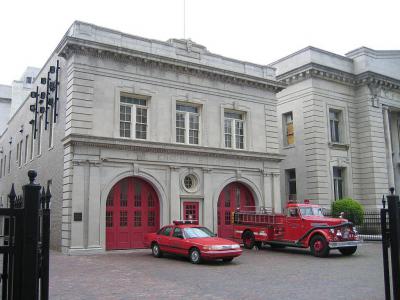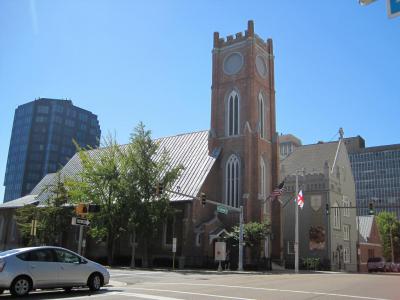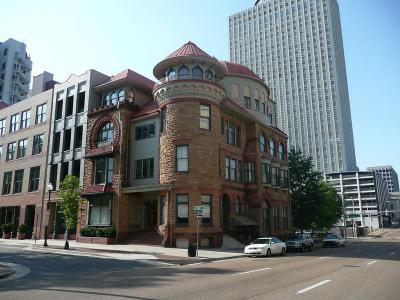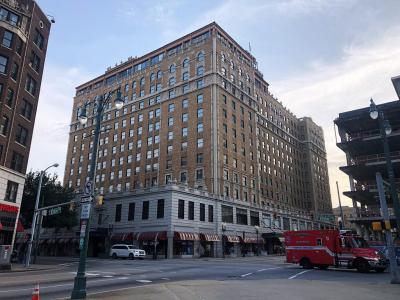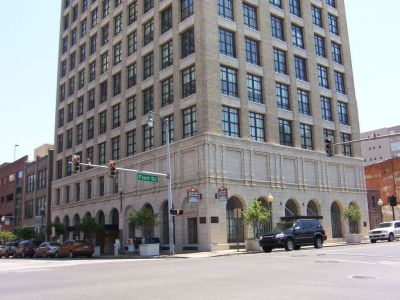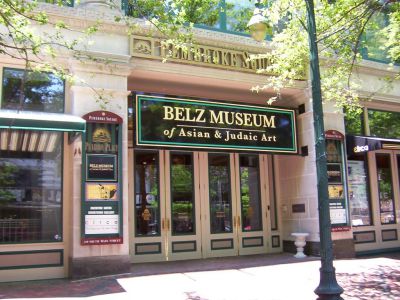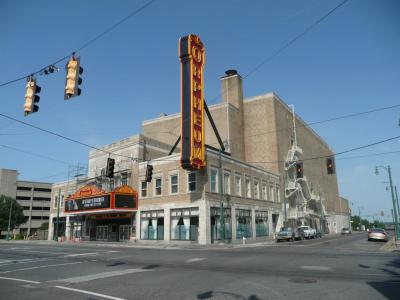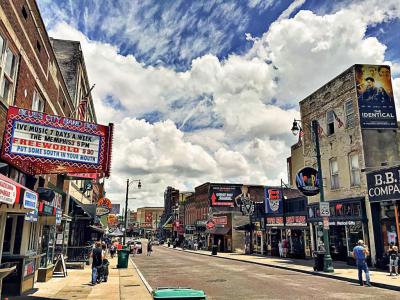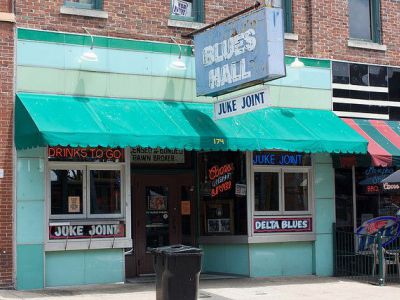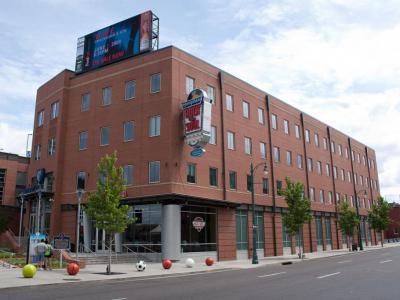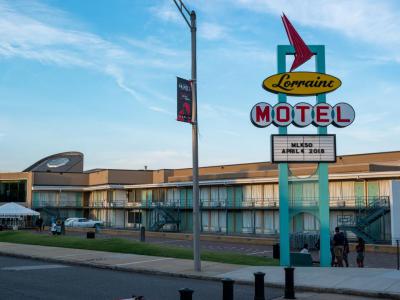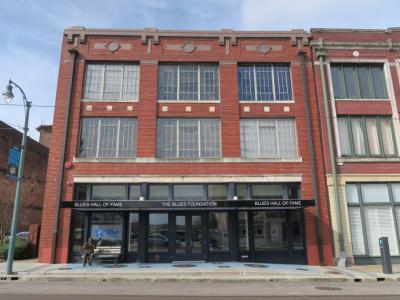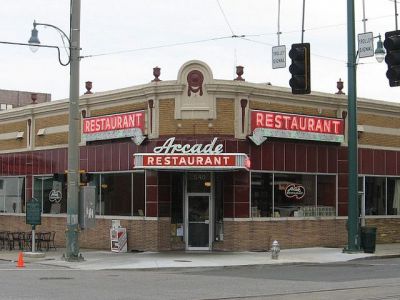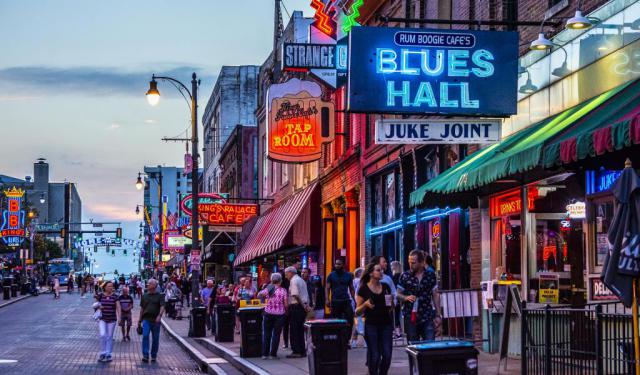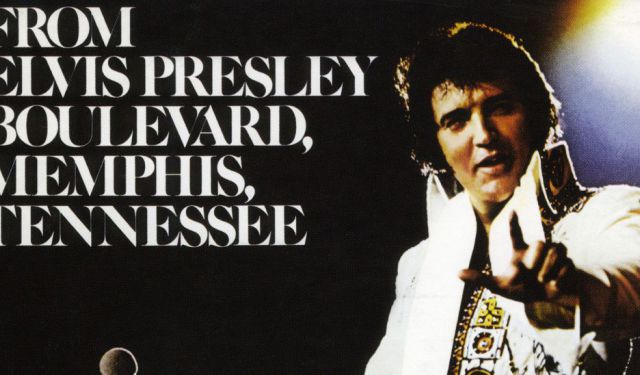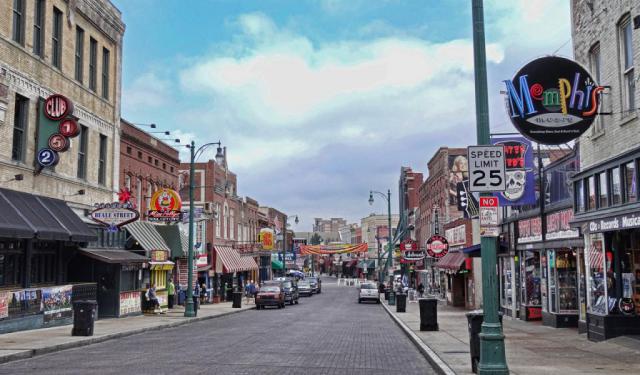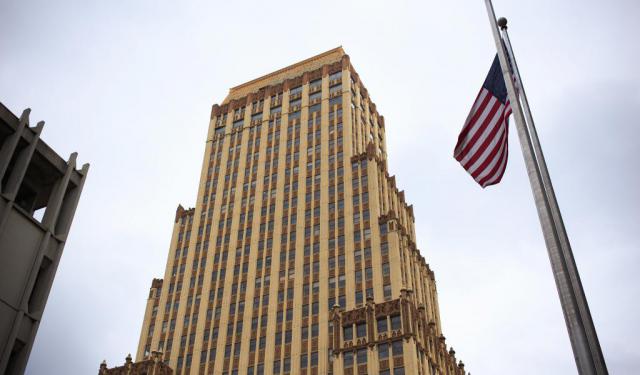Memphis Downtown Walking Tour (Self Guided), Memphis
Downtown is the oldest part of Memphis. This vibrant and culturally rich district is home to a variety of historical, artistic, and entertainment destinations that collectively reflect the unique heritage and spirit of the “blues city”.
One of the area's standout attractions is the Fire House Museum, a fascinating spot where visitors can explore the history of the city's fire department and its heroic firefighters. Nearby, the Calvary Episcopal Church stands as an architectural gem, showcasing Gothic Revival design and offering a serene retreat from the urban hustle and bustle.
For those keen on legal history, the Burch, Porter & Johnson's Historic Location may be of interest as a law firm with a long-standing presence in the city. Meanwhile, the Peabody Hotel, a luxurious and iconic landmark, is famous for its daily duck march in the lobby.
History enthusiasts also can delve into Memphis' cotton trading past at the Cotton Museum at the Memphis Cotton Exchange. At the same time, art lovers can admire the impressive collections at the Belz Museum of Asian and Judaic Art.
For entertainment, the Orpheum Theatre is a must-visit spot. This classic venue regularly hosts live performances, including Broadway shows and concerts. And of course, no trip to Memphis Downtown would be complete without experiencing the rhythm and soul of Beale Street. Here, you can savor delicious cuisine, enjoy live music, and soak in the vibrant atmosphere.
For blues aficionados, Mr Handy's Blues Hall and the Blues Hall of Fame are pilgrimage sites that celebrate the genre's legends.
You can further immerse yourself in the history of Memphis at the Memphis Rock 'n' Soul Museum and the National Civil Rights Museum, both of which offer insightful exhibits and poignant narratives.
Lastly, don't forget to grab a bite at the historic Arcade Restaurant, serving up classic Southern diner fare since 1919.
Undoubtedly, Downtown Memphis is the soulful and captivating core of the city. To acquaint yourself fully with and find your way to its prominent highlights in the shortest possible time, take this self-guided tour and enjoy a truly unforgettable experience!
One of the area's standout attractions is the Fire House Museum, a fascinating spot where visitors can explore the history of the city's fire department and its heroic firefighters. Nearby, the Calvary Episcopal Church stands as an architectural gem, showcasing Gothic Revival design and offering a serene retreat from the urban hustle and bustle.
For those keen on legal history, the Burch, Porter & Johnson's Historic Location may be of interest as a law firm with a long-standing presence in the city. Meanwhile, the Peabody Hotel, a luxurious and iconic landmark, is famous for its daily duck march in the lobby.
History enthusiasts also can delve into Memphis' cotton trading past at the Cotton Museum at the Memphis Cotton Exchange. At the same time, art lovers can admire the impressive collections at the Belz Museum of Asian and Judaic Art.
For entertainment, the Orpheum Theatre is a must-visit spot. This classic venue regularly hosts live performances, including Broadway shows and concerts. And of course, no trip to Memphis Downtown would be complete without experiencing the rhythm and soul of Beale Street. Here, you can savor delicious cuisine, enjoy live music, and soak in the vibrant atmosphere.
For blues aficionados, Mr Handy's Blues Hall and the Blues Hall of Fame are pilgrimage sites that celebrate the genre's legends.
You can further immerse yourself in the history of Memphis at the Memphis Rock 'n' Soul Museum and the National Civil Rights Museum, both of which offer insightful exhibits and poignant narratives.
Lastly, don't forget to grab a bite at the historic Arcade Restaurant, serving up classic Southern diner fare since 1919.
Undoubtedly, Downtown Memphis is the soulful and captivating core of the city. To acquaint yourself fully with and find your way to its prominent highlights in the shortest possible time, take this self-guided tour and enjoy a truly unforgettable experience!
How it works: Download the app "GPSmyCity: Walks in 1K+ Cities" from Apple App Store or Google Play Store to your mobile phone or tablet. The app turns your mobile device into a personal tour guide and its built-in GPS navigation functions guide you from one tour stop to next. The app works offline, so no data plan is needed when traveling abroad.
Memphis Downtown Walking Tour Map
Guide Name: Memphis Downtown Walking Tour
Guide Location: USA » Memphis (See other walking tours in Memphis)
Guide Type: Self-guided Walking Tour (Sightseeing)
# of Attractions: 13
Tour Duration: 2 Hour(s)
Travel Distance: 3.1 Km or 1.9 Miles
Author: val
Sight(s) Featured in This Guide:
Guide Location: USA » Memphis (See other walking tours in Memphis)
Guide Type: Self-guided Walking Tour (Sightseeing)
# of Attractions: 13
Tour Duration: 2 Hour(s)
Travel Distance: 3.1 Km or 1.9 Miles
Author: val
Sight(s) Featured in This Guide:
- Fire House Museum of Memphis
- Calvary Episcopal Church
- Burch, Porter & Johnson's Historic Location
- Peabody Hotel
- Cotton Museum at the Memphis Cotton Exchange
- Belz Museum of Asian and Judaic Art
- Orpheum Theatre
- Beale Street
- Mr. Handy's Blues Hall
- Memphis Rock 'n' Soul Museum
- National Civil Rights Museum
- Blues Hall of Fame
- Arcade Restaurant
1) Fire House Museum of Memphis
The Fire House Museum of Memphis is an interactive museum dedicated to displaying the history of Memphis’ first fire station. The museum collection contains items that date back to the early 1900s. The Hale Water Tower, the 1929 American LaFrance Pumper, helmets, badges, lanterns, a display of the station as it appeared in 1910, and desks of fire chiefs from the past are some of the many items that you will find here.
Whether you want to fight a simulated fire from a snorkel basket, or feel the heat from the fire room, there is something for everyone at the Fire House. The Memorial Wall pays homage to local firefighters who died in the line of duty, and there is an oil painting depicting scenes of actual fires. In addition, the first class of black fire fighters is honored via a set of photographs and paintings. Even children will have the opportunity to have fun by exploring an ambulance unit or the cabin of a fire truck.
The museum shop sells jewelry, toys, souvenirs, clothing, and other items that promote fire safety. In addition, they offer fire safety field trips and workshops.
Whether you want to fight a simulated fire from a snorkel basket, or feel the heat from the fire room, there is something for everyone at the Fire House. The Memorial Wall pays homage to local firefighters who died in the line of duty, and there is an oil painting depicting scenes of actual fires. In addition, the first class of black fire fighters is honored via a set of photographs and paintings. Even children will have the opportunity to have fun by exploring an ambulance unit or the cabin of a fire truck.
The museum shop sells jewelry, toys, souvenirs, clothing, and other items that promote fire safety. In addition, they offer fire safety field trips and workshops.
2) Calvary Episcopal Church
Located at the intersection of North Second Street and Adams Avenue, the Calvary Episcopal Church is part of the Episcopal Diocese of West Tennessee. It is the oldest public building in continuous use in the city of Memphis. It was founded in 1832 and is considered the “Mother Parish” of Memphis and Shelby County. The church also founded additional congregations, Grace Church, Saint Mary’s Cathedral, and the Church of the Holy Communion. The building was designed by the Reverend Philip Alston. It was placed on the National Register of Historic Places in 1982.
Serving the community is what the church strives to do. They offer a Calvary Place Child Care Center for working parents and a Waffle Shop that provides weekday meals during Lent. Their Soup Sunday program sells soup at an affordable price and the proceeds are used to feed Memphis’ hungry. The church offers grants to further its mission. They also have a Community Service Ministry that helps to support the needs of those within the area.
Faith formation classes are offered for adults and children.
Serving the community is what the church strives to do. They offer a Calvary Place Child Care Center for working parents and a Waffle Shop that provides weekday meals during Lent. Their Soup Sunday program sells soup at an affordable price and the proceeds are used to feed Memphis’ hungry. The church offers grants to further its mission. They also have a Community Service Ministry that helps to support the needs of those within the area.
Faith formation classes are offered for adults and children.
3) Burch, Porter & Johnson's Historic Location
One important landmark in Memphis is the Burch, Porter & Johnson's Law Firm. Located on Court Avenue, the building has played a significant part in Memphis history. The firm is composed of two buildings, the Tennessee Club Building and the Goodbar Building. Construction joined the two together in 1982.
The firm represented Dr. Martin Luther King during the Memphis Sanitation March in 1968, and was in court representing him when they heard of the assassination attempt that took his life.
The Tennessee Club Building was erected in 1890 by Edward Terrell, and functioned as an art gallery, library and social club. Carrie Nation gave a speech on the club’s front stairs and William H. Taft and Teddy Roosevelt visited the building. It has been listed on the National Register of Historic Places since April 22, 1982.
The firm represented Dr. Martin Luther King during the Memphis Sanitation March in 1968, and was in court representing him when they heard of the assassination attempt that took his life.
The Tennessee Club Building was erected in 1890 by Edward Terrell, and functioned as an art gallery, library and social club. Carrie Nation gave a speech on the club’s front stairs and William H. Taft and Teddy Roosevelt visited the building. It has been listed on the National Register of Historic Places since April 22, 1982.
4) Peabody Hotel (must see)
The Peabody Hotel is a four star hotel best known for its most famous residents, the Peabody Ducks. Each day at 11 am, the ducks march into the hotel lobby for a swim in the fountain. They are accompanied by the duck master and the King Cotton March by John Phillip Sousa. The ducks are a popular attraction and hundreds of people line up to see them every day. In addition, many celebrities have acted as an honorary duck master throughout the years.
The duck tradition began in 1932 when the general manager and his friend placed live decoy ducks in the hotel lobby fountain as a joke. The public liked it and the tradition continued with five mallard ducks, one male and four female. The ducks work an average of three months before they are retired.
The original Peabody Hotel was built by Robert Campbell Brinkley in 1869 and was located on the corner of Main and Monroe Streets. Its most famous resident was Jefferson Davis, the former President of the Confederacy.
The current hotel was designed by Walter W. Ahlschlager and opened in 1925. In 1965, the hotel went bankrupt and was sold to the Sheraton Hotels, renamed the Sheraton–Peabody Hotel. After the Sheraton closed in 1973, Isadore Edwin Hanover bought the hotel and sold it to his son-in-law, Jack A. Belz. After years of restoration work, the building reopened in 1981.
The Peabody Skyway, a top floor that contains a lounge, bar, and ballroom, was a popular hangout during the 1940s. The hotel Plantation Roof offers great views of the Memphis skyline and is the site of the famous Thursday night "Rooftop Parties.”
Bernard Lansky's store, located in the hotel's lobby, is legendary. Elvis used to called him "Mr. Lansky," while faithful customers call him "Mr. B.", and the world knows him as "Clothier to the Stars". Elvis collaborated with Mr Lansky throughout the course of his career. When he first bought a shirt from Lansky it the 1950s, it cost just $3.95. As Elvis became more famous, Lansky was named his PR man all over the world. Frank Sinatra, Carl Perkins, and B.B. King have also shopped at Lansky at the Peabody.
***Elvis Presley Walk***
This hotel is where Elvis went for his senior prom. He is rumored to have told his date that he didn’t dance and was incredibly nervous the whole night – a hard to believe line from a man who swayed his hips and made the girls swoon.
In the Hotel's Memorabilia Room one can still see the contract signed by Elvis Presley in the hotel lobby when he left the Sun Records for RCA.
The duck tradition began in 1932 when the general manager and his friend placed live decoy ducks in the hotel lobby fountain as a joke. The public liked it and the tradition continued with five mallard ducks, one male and four female. The ducks work an average of three months before they are retired.
The original Peabody Hotel was built by Robert Campbell Brinkley in 1869 and was located on the corner of Main and Monroe Streets. Its most famous resident was Jefferson Davis, the former President of the Confederacy.
The current hotel was designed by Walter W. Ahlschlager and opened in 1925. In 1965, the hotel went bankrupt and was sold to the Sheraton Hotels, renamed the Sheraton–Peabody Hotel. After the Sheraton closed in 1973, Isadore Edwin Hanover bought the hotel and sold it to his son-in-law, Jack A. Belz. After years of restoration work, the building reopened in 1981.
The Peabody Skyway, a top floor that contains a lounge, bar, and ballroom, was a popular hangout during the 1940s. The hotel Plantation Roof offers great views of the Memphis skyline and is the site of the famous Thursday night "Rooftop Parties.”
Bernard Lansky's store, located in the hotel's lobby, is legendary. Elvis used to called him "Mr. Lansky," while faithful customers call him "Mr. B.", and the world knows him as "Clothier to the Stars". Elvis collaborated with Mr Lansky throughout the course of his career. When he first bought a shirt from Lansky it the 1950s, it cost just $3.95. As Elvis became more famous, Lansky was named his PR man all over the world. Frank Sinatra, Carl Perkins, and B.B. King have also shopped at Lansky at the Peabody.
***Elvis Presley Walk***
This hotel is where Elvis went for his senior prom. He is rumored to have told his date that he didn’t dance and was incredibly nervous the whole night – a hard to believe line from a man who swayed his hips and made the girls swoon.
In the Hotel's Memorabilia Room one can still see the contract signed by Elvis Presley in the hotel lobby when he left the Sun Records for RCA.
5) Cotton Museum at the Memphis Cotton Exchange
The Cotton Museum at the Memphis Cotton Exchange is an exhibition hall that tells you everything you ever wanted to know about cotton. Located on the corner of Front Street and Union Avenue, the building is where cotton farmers would bring their bounty to sell to traders who would sell their purchases to textile manufacturers around the world. The museum gives patrons a glimpse into the history of the cotton industry in Memphis from the 1920s to present times.
Memphis is and was one of the biggest spot-cotton markets in the world. In 1874, the Memphis Cotton Exchange was established to help regulate that market. Some of the items visitors will see are cotton gins, bales of cotton, a 135-foot custom mural by Memphis artist David Mah, a Western Union telegraph, the trading board used to make transactions, and a display featuring clothing from the Cotton Carnivals of the days long gone by.
It is highly recommended to take the Legends of Cotton Row tour that shows visitors to downtown Memphis where many cotton transactions occurred. The museum also offers brown bag lunch lectures on the third Thursday of each month.
Memphis is and was one of the biggest spot-cotton markets in the world. In 1874, the Memphis Cotton Exchange was established to help regulate that market. Some of the items visitors will see are cotton gins, bales of cotton, a 135-foot custom mural by Memphis artist David Mah, a Western Union telegraph, the trading board used to make transactions, and a display featuring clothing from the Cotton Carnivals of the days long gone by.
It is highly recommended to take the Legends of Cotton Row tour that shows visitors to downtown Memphis where many cotton transactions occurred. The museum also offers brown bag lunch lectures on the third Thursday of each month.
6) Belz Museum of Asian and Judaic Art (must see)
Located on South Main Street, the Belz Museum of Asian and Judaic Art contains the largest collection of Chinese art (tapestries, furniture, carvings, and other artifacts from the Qing period) in the southern United States and an impressive collection of items related to Judaism, totaling over 1,000. The exhibition hall was established in 1998.
Most of the artifacts come from the private collection of Jack and Marilyn Betz. Among these are the works by Ofra Friedland, Daniel Kafr, Marc Chagall, Mane Katz. Of special interest are the 32 bronze sculptures created by Daniel Kafri.
Tours are available Tuesday through Friday from 10 am to 4 pm. Docent tours are also available to the public upon request. In addition, there are tours specifically targeted towards educating students. Photography and movie and video cameras are not allowed in the galleries. The museum’s Dynasty room is available for rental for groups of 25 or more who wish to experience a Chinese feast with tea. The museum shop sells cards, gifts, and other accessories reflecting a Judaic or Asian theme.
Most of the artifacts come from the private collection of Jack and Marilyn Betz. Among these are the works by Ofra Friedland, Daniel Kafr, Marc Chagall, Mane Katz. Of special interest are the 32 bronze sculptures created by Daniel Kafri.
Tours are available Tuesday through Friday from 10 am to 4 pm. Docent tours are also available to the public upon request. In addition, there are tours specifically targeted towards educating students. Photography and movie and video cameras are not allowed in the galleries. The museum’s Dynasty room is available for rental for groups of 25 or more who wish to experience a Chinese feast with tea. The museum shop sells cards, gifts, and other accessories reflecting a Judaic or Asian theme.
7) Orpheum Theatre (must see)
Located on South Main Street, the Orpheum Theatre is one of the last movie palaces from the 1920s still in existence. Originally built in 1890, it was known as the Grand Opera House. Today it is a home to the Ballet Memphis and Opera Memphis troupes.
Broadway, film, and concerts are staged here on a regular basis. Cats, Mamma Mia, and Joseph and the Amazing Technicolor Dreamcoat are just a few of the shows that have graced the Orpheum’s stage over the years.
The theater has staying power. It survived a 1923 fire, bankruptcy, demolition, and the decline of the city. Through all of its trials, the Orpheum has rebounded and today remains one of the “South’s Finest Theatres.” In 1976, it underwent a $5 million renovation that restored the theater to its former 1928 glory.
It is rumored that the building is haunted by two ghosts. One of the ghosts is a nine year old girl named Mary and the other is a masked figure who lives in the air ducts above the house. Mary likes to slam doors and make lights flicker. The ghost with no name likes to wave at audience members.
The theater is available for rental and offers many programs to educate the public about the arts. In addition, tours are available for groups at different times throughout the year.
Broadway, film, and concerts are staged here on a regular basis. Cats, Mamma Mia, and Joseph and the Amazing Technicolor Dreamcoat are just a few of the shows that have graced the Orpheum’s stage over the years.
The theater has staying power. It survived a 1923 fire, bankruptcy, demolition, and the decline of the city. Through all of its trials, the Orpheum has rebounded and today remains one of the “South’s Finest Theatres.” In 1976, it underwent a $5 million renovation that restored the theater to its former 1928 glory.
It is rumored that the building is haunted by two ghosts. One of the ghosts is a nine year old girl named Mary and the other is a masked figure who lives in the air ducts above the house. Mary likes to slam doors and make lights flicker. The ghost with no name likes to wave at audience members.
The theater is available for rental and offers many programs to educate the public about the arts. In addition, tours are available for groups at different times throughout the year.
8) Beale Street (must see)
Beale Street, often referred to as the "Home of the Blues," holds a prominent place in Memphis as one of America's most renowned streets, particularly in the realm of entertainment. In 1909, a notable event took place on this very street when W. C. Handy composed a campaign song called "Mr. Crump" for E. H. Crump, a prominent figure in the political machine. This song was later renamed "The Memphis Blues." Additionally, in 1916, Handy penned another influential piece entitled "Beale Street Blues," which played a pivotal role in the decision to change the street's name from Beale Avenue to Beale Street.
From the 1920s to the 1940s, Beale Street witnessed the performances of legendary musicians such as Louis Armstrong, Muddy Waters, Albert King, Memphis Minnie, B. B. King, Rufus Thomas, Rosco Gordon, and others. Their contributions significantly shaped the musical style known as Memphis Blues. Notably, B. B. King was introduced as "the Beale Street Blues Boy" during his early career.
Beale Street holds great historical significance for the city and the blues music genre. In recognition of its importance, the stretch of the street spanning from Main to 4th Street was designated as a National Historic Landmark on May 23, 1966. In the present day, the blues clubs and restaurants along Beale Street are major attractions for tourists visiting Memphis. The street frequently hosts festivals and outdoor concerts, drawing substantial crowds to the area. Moreover, more than 25 clubs and shops selling Memphis-themed souvenirs can be found in this vibrant locale.
Why You Should Visit:
To enjoy authentic Memphis soul food, listen to live music, or party!
***Elvis Presley Walk***
The young Elvis used to spend a lot of time with the musicians gathered on Beale street. The music and the vibe of the street had a great influence on him. Today, his name can be spotted on one of the brass notes on the Beale Street Brass Notes Walk of Fame.
From the 1920s to the 1940s, Beale Street witnessed the performances of legendary musicians such as Louis Armstrong, Muddy Waters, Albert King, Memphis Minnie, B. B. King, Rufus Thomas, Rosco Gordon, and others. Their contributions significantly shaped the musical style known as Memphis Blues. Notably, B. B. King was introduced as "the Beale Street Blues Boy" during his early career.
Beale Street holds great historical significance for the city and the blues music genre. In recognition of its importance, the stretch of the street spanning from Main to 4th Street was designated as a National Historic Landmark on May 23, 1966. In the present day, the blues clubs and restaurants along Beale Street are major attractions for tourists visiting Memphis. The street frequently hosts festivals and outdoor concerts, drawing substantial crowds to the area. Moreover, more than 25 clubs and shops selling Memphis-themed souvenirs can be found in this vibrant locale.
Why You Should Visit:
To enjoy authentic Memphis soul food, listen to live music, or party!
***Elvis Presley Walk***
The young Elvis used to spend a lot of time with the musicians gathered on Beale street. The music and the vibe of the street had a great influence on him. Today, his name can be spotted on one of the brass notes on the Beale Street Brass Notes Walk of Fame.
9) Mr. Handy's Blues Hall
Mr. Handy's Blues Hall is the last standing real juke joint on the Beal. Located next door to and connected with Rum Boogie Café, this storied honky-tonk hosts some of the best blues artists in town, who play live music "8 days a week!". Filled with rock memorabilia, The Handy refers to W.C. Handy, the father of the blues.
Smaller than most of the other clubs on the street, the walls here – adorned with random stuff and historic photos of the W.C. Handy family and other blues memorabilia – evoke the real feel of a juke joint, with tables crammed into the tiny space, worn wood floors and, of course, real blues being played. The latter is the main draw to the Blues Hall, so be sure to stop in, grab a seat (if you can find one), enjoy a Beale Street Big Ass Beer, and listen to the best blues in Memphis!
Why You Should Visit:
To listen to blues, blues and more blues! To experience the real thing at the only authentic juke joint left on Beale Street. To enjoy local bands playing the Memphis blues, both classics and originals, during the week and on weekends!
Tip:
The place also serves up Southern grub, in case you are hungry for something more than just pure entertainment, with barbecue being one of the customer favorites.
There are no bathrooms within Mr. Handy's, but there's a door connecting the club to Rum Boogie, which is full-service in that regard.
Smaller than most of the other clubs on the street, the walls here – adorned with random stuff and historic photos of the W.C. Handy family and other blues memorabilia – evoke the real feel of a juke joint, with tables crammed into the tiny space, worn wood floors and, of course, real blues being played. The latter is the main draw to the Blues Hall, so be sure to stop in, grab a seat (if you can find one), enjoy a Beale Street Big Ass Beer, and listen to the best blues in Memphis!
Why You Should Visit:
To listen to blues, blues and more blues! To experience the real thing at the only authentic juke joint left on Beale Street. To enjoy local bands playing the Memphis blues, both classics and originals, during the week and on weekends!
Tip:
The place also serves up Southern grub, in case you are hungry for something more than just pure entertainment, with barbecue being one of the customer favorites.
There are no bathrooms within Mr. Handy's, but there's a door connecting the club to Rum Boogie, which is full-service in that regard.
10) Memphis Rock 'n' Soul Museum (must see)
Located on the famous Beale Street, the Memphis Rock ‘n’ Soul Museum tells the story of Memphis music from its early beginnings to the present. Educating the masses about the music is the central theme of the museum and the seven galleries herein showcase a wide variety of genres, from the music sung in the fields to gospel, blues, country, rhythm and blues, and rock ‘n’ roll.
The museum was created by the Smithsonian Institution in 2000 as a research project. Visitors will enjoy the videos, recordings, photographs of artists such as, Otis Redding, Al Green, and Earth, Wind, and Fire.
Three recommended tour stops are the Bravo Gallery that honors artists who made an impact on the world music, the Soul Music exhibit that features the works of legendary record labels such as STAX, HI Records and Sun Records, and the Youth Culture exhibit that features artifacts from the record company that helped Elvis Presley and Jerry Lee Lewis get their start.
The on-site Levy Restaurants offers catering services for a variety of functions at the exhibition hall.
The museum was created by the Smithsonian Institution in 2000 as a research project. Visitors will enjoy the videos, recordings, photographs of artists such as, Otis Redding, Al Green, and Earth, Wind, and Fire.
Three recommended tour stops are the Bravo Gallery that honors artists who made an impact on the world music, the Soul Music exhibit that features the works of legendary record labels such as STAX, HI Records and Sun Records, and the Youth Culture exhibit that features artifacts from the record company that helped Elvis Presley and Jerry Lee Lewis get their start.
The on-site Levy Restaurants offers catering services for a variety of functions at the exhibition hall.
11) National Civil Rights Museum (must see)
The National Civil Rights Museum is located at the former Lorraine Motel where Martin Luther King, Jr. was assassinated in 1968. It also includes the Canipe’s Amusement Store located next to the rooming house where James Earl Ray, the man who shot Dr. King, stayed and the Young and Morrow Building where Mr. Ray confessed. The museum officially opened in 1991.
The Lorraine Motel was one of the few comfortable places where black people could safely stay during segregation. The museum tells the history of the African American struggle from the 17th century to the present. In addition, police and evidence files from the assassination are on display.
Visitors can purchase civil rights-related materials at the museum bookstore.
In addition to serving as a civil rights museum, several rooms are available for seminars, meetings, or events. Room size varies, with the largest room accommodating up to 276 people.
The Lorraine Motel was one of the few comfortable places where black people could safely stay during segregation. The museum tells the history of the African American struggle from the 17th century to the present. In addition, police and evidence files from the assassination are on display.
Visitors can purchase civil rights-related materials at the museum bookstore.
In addition to serving as a civil rights museum, several rooms are available for seminars, meetings, or events. Room size varies, with the largest room accommodating up to 276 people.
12) Blues Hall of Fame
The Blues Hall of Fame is a music museum located in Memphis that holds great value for both avid blues enthusiasts and casual tourists. Originally, the "Blues Hall of Fame" was not a physical structure but rather a recognition of individuals who made significant contributions to blues music. It was established in 1980 by the Blues Foundation to honor those who have made notable contributions to the world of blues through their performances, recordings, or documentation. The actual physical museum opened its doors to the public on May 8, 2015.
Presently, the museum boasts comprehensive exhibits and an in-depth historical perspective, providing visitors with an immersive experience in the world of blues culture. In total, it showcases over 400 inductees across five primary categories: Performer, Individual, Album, Single, and Literature.
Within the museum, you'll find ten distinct galleries equipped with interactive touchscreens, as well as three central databases where visitors can listen to music, watch videos, and delve into the life stories of each of the honored inductees. Each gallery also features unique memorabilia, such as Charlie Musselwhite's harmonica, rare album covers, tour jackets, Mavis Staples' Grammy gown, Otis Spann's piano, and other iconic artifacts. Additionally, there are rotating traveling exhibits upstairs that change every four months, providing fresh experiences for guests.
The museum was made possible through the generosity and support of blues enthusiasts, with the aim of fulfilling all four aspects of The Blues Foundation's mission: preserving the history of blues, celebrating excellence within the genre, supporting education related to blues, and ensuring the future of this cherished musical tradition.
Presently, the museum boasts comprehensive exhibits and an in-depth historical perspective, providing visitors with an immersive experience in the world of blues culture. In total, it showcases over 400 inductees across five primary categories: Performer, Individual, Album, Single, and Literature.
Within the museum, you'll find ten distinct galleries equipped with interactive touchscreens, as well as three central databases where visitors can listen to music, watch videos, and delve into the life stories of each of the honored inductees. Each gallery also features unique memorabilia, such as Charlie Musselwhite's harmonica, rare album covers, tour jackets, Mavis Staples' Grammy gown, Otis Spann's piano, and other iconic artifacts. Additionally, there are rotating traveling exhibits upstairs that change every four months, providing fresh experiences for guests.
The museum was made possible through the generosity and support of blues enthusiasts, with the aim of fulfilling all four aspects of The Blues Foundation's mission: preserving the history of blues, celebrating excellence within the genre, supporting education related to blues, and ensuring the future of this cherished musical tradition.
13) Arcade Restaurant
Located in the middle of historic Memphis, the Arcade Restaurant is honored for being the oldest eatery in the city. Speros Zepatos, a Greek immigrant, founded the diner in 1919 in what was then a small, wood-framed building. Food was cooked on potbelly stoves! In 1925, Speros, who gave the Arcade its original name, rebuilt it in Greek revival style, complete with retail stores to signify the “Arcade” title.
Nowadays, this third-generation family-owned restaurant serves generous portions of southern-style breakfast which made them a featured restaurant on The Food Network and The Travel Channel. Their signature sweet potato pancakes alone have put the Arcade on the map – that and the Elvis booth in which “The King” used to order his beloved fried peanut butter and banana sandwich. Lunchtime at the Arcade will give you the choice of a meat and two daily special, salads, sandwiches and the like. But, you must try their pizza for which they use fresh ingredients and great toppings served on a crispy crust.
The longevity, great food and the fact that that Elvis was a regular here has made the Arcade a firm favorite of locals and the media alike. The restaurant has always attracted famous guests and been featured in a number of movies, such as Mystery Train, 21 Grams, Elizabethtown, The Client, The Firm, and Walk the Line, to name but a few.
The evenings are reserved for private functions except for Trolley Nights (last Friday of the month) when they serve dinner until 11 pm.
Nowadays, this third-generation family-owned restaurant serves generous portions of southern-style breakfast which made them a featured restaurant on The Food Network and The Travel Channel. Their signature sweet potato pancakes alone have put the Arcade on the map – that and the Elvis booth in which “The King” used to order his beloved fried peanut butter and banana sandwich. Lunchtime at the Arcade will give you the choice of a meat and two daily special, salads, sandwiches and the like. But, you must try their pizza for which they use fresh ingredients and great toppings served on a crispy crust.
The longevity, great food and the fact that that Elvis was a regular here has made the Arcade a firm favorite of locals and the media alike. The restaurant has always attracted famous guests and been featured in a number of movies, such as Mystery Train, 21 Grams, Elizabethtown, The Client, The Firm, and Walk the Line, to name but a few.
The evenings are reserved for private functions except for Trolley Nights (last Friday of the month) when they serve dinner until 11 pm.
Walking Tours in Memphis, Tennessee
Create Your Own Walk in Memphis
Creating your own self-guided walk in Memphis is easy and fun. Choose the city attractions that you want to see and a walk route map will be created just for you. You can even set your hotel as the start point of the walk.
Memphis Blues Walking Tour
If you're a music fan, visiting Memphis, Tennessee, is a must! As the cradle of blues, this city has influenced many musicians and music lovers worldwide. The soulful blues genre is deeply rooted in the history of Memphis. Below is just a sample of an awesome list of places to learn more about Memphis Blues’ juicy past, present, and future.
One of the essential stops for any blues... view more
Tour Duration: 2 Hour(s)
Travel Distance: 1.8 Km or 1.1 Miles
One of the essential stops for any blues... view more
Tour Duration: 2 Hour(s)
Travel Distance: 1.8 Km or 1.1 Miles
Elvis Presley Walking Tour
Above all other celebrities, Memphis, Tennessee, is primarily associated with Elvis Aaron Presley (known to the majority worldwide simply as Elvis). Thus, it is not at all surprising that Memphis serves as a sort of shrine to the man and his music. Even though Presley passed away in 1977, his fans keep flocking into the city to this day to pay their respects to the King of Rock 'n' Roll.... view more
Tour Duration: 2 Hour(s)
Travel Distance: 3.5 Km or 2.2 Miles
Tour Duration: 2 Hour(s)
Travel Distance: 3.5 Km or 2.2 Miles
Memphis Introduction Walking Tour
One of the most iconic destinations in the United States, the city of Memphis has gone down in history for many different reasons. Set on a bluff over the Mississippi River, the site of today's Memphis has been settled for over a thousand years by various cultures, including the Indian tribe of Chickasaw. The latter encountered European explorers in the 16th century. In the 18th century,... view more
Tour Duration: 2 Hour(s)
Travel Distance: 2.4 Km or 1.5 Miles
Tour Duration: 2 Hour(s)
Travel Distance: 2.4 Km or 1.5 Miles
Historical Buildings Walking Tour
A substantial part of Memphis' heritage is manifested in its iconic buildings. By far more than just bricks and mortar, they are a history window through which one can observe the city's growth and development over the years. Here's a brief overview of some of these notable structures.
Harsson-Goyer-Lee House: This charming 19th-century mansion stands as a testament to... view more
Tour Duration: 2 Hour(s)
Travel Distance: 3.1 Km or 1.9 Miles
Harsson-Goyer-Lee House: This charming 19th-century mansion stands as a testament to... view more
Tour Duration: 2 Hour(s)
Travel Distance: 3.1 Km or 1.9 Miles
The Most Popular Cities
/ view all
